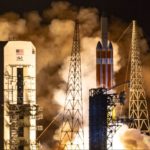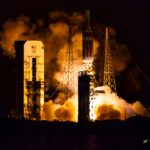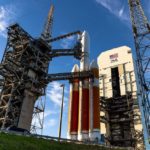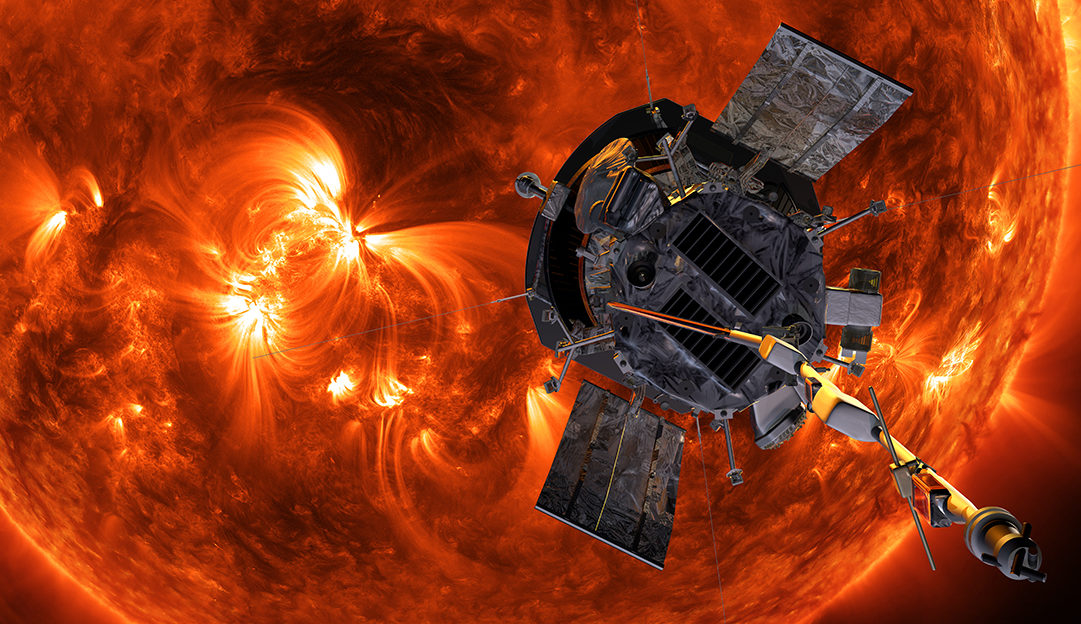
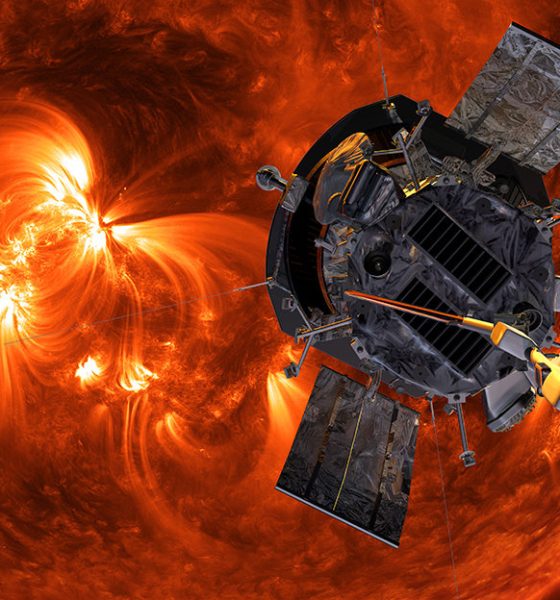
News
NASA’s Parker Solar Probe takes first picture inside the Sun’s atmosphere
Traveling at the record-breaking speed of 213,200 miles per hour, NASA’s Parker Solar Probe came within 15 million miles of the Sun’s surface, completing its first solar encounter phase and rewarding scientists with the first picture ever taken from within our star’s atmosphere.
Launched on August 12, 2018 in a United Launch Alliance Delta IV Heavy rocket from Cape Canaveral, Florida, the probe will help provide answers to some of the mysteries of our Sun. In particular: Why is the atmosphere hotter than the surface? Why is the solar wind continuously accelerated? These are important questions considering the Sun is both essential for life and a potential danger through its magnetized materials’ interference with our satellites, electronics, and astronauts in orbit. Scientists on the craft’s team presented the initial set of new data from its encounter on December 12th during the 2018 American Geophysical Union meeting.
The Parker Probe’s team began downloading data from its journey on December 7th this year, but the actual Sun passage took place about a month earlier, from October 31st through November 11th. The delay was caused by the nature of the Sun itself – as a wide band radio source, communications are not possible anytime a craft is in front, behind, or to the side of it.
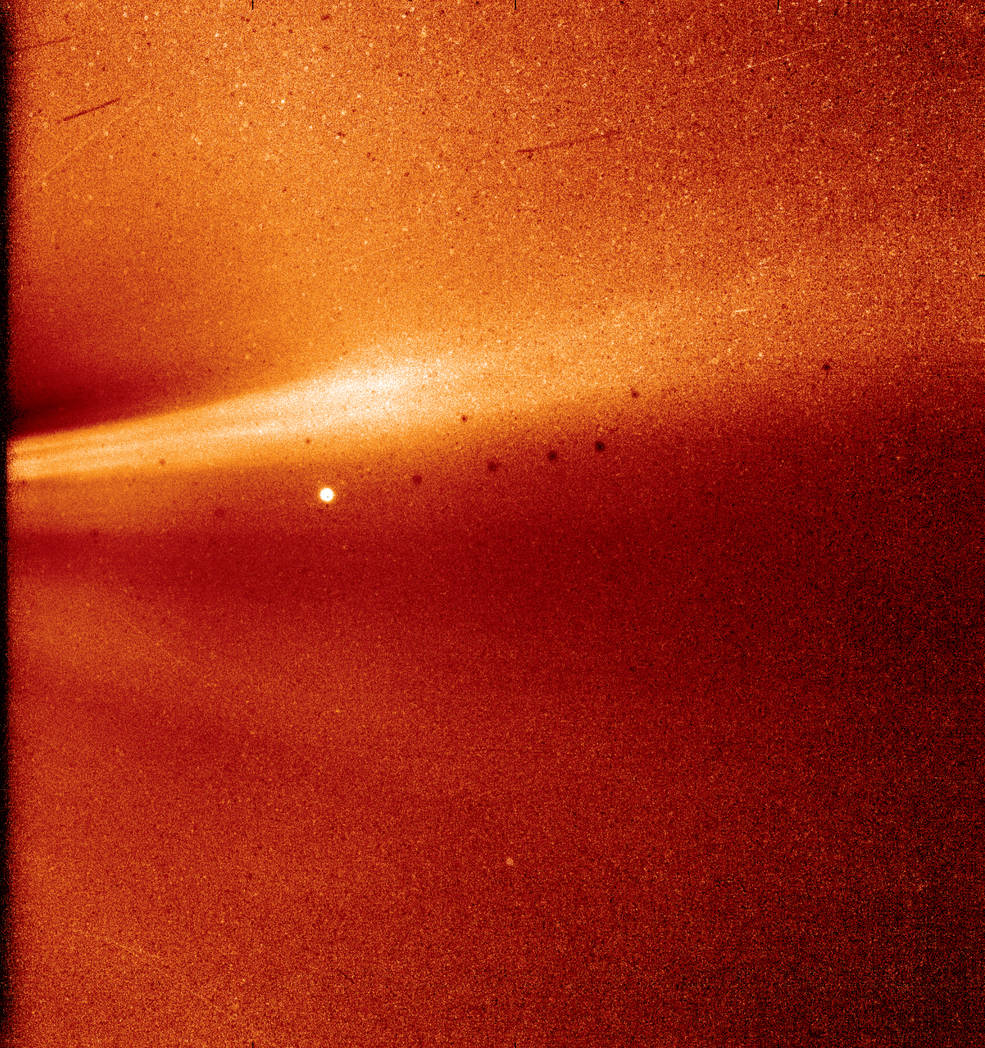
During the probe’s approaches, scientists rely on one of four beacons installed that signal the craft’s status. Mission controllers at the John Hopkins University Applied Physics Labs (JHUAPL) received the “A” beacon at 4:46 pm EST on November 7, 2018, indicating that the probe was operating well and collecting data. Also, more data from the probe’s initial encounter will be forthcoming next year following its next approach.
This latest visitor to the Sun was named after physicist Eugene Newman Parker, best known for his mid-1950s theories about solar wind and the Sun’s atmosphere being hotter than the surface itself, and the craft will likely be one more data point complimenting his predictions. Since the Parker Probe’s mission will encounter our star in ways never done before, its science team is not quite sure of what to expect.
“Parker is an exploration mission — the potential for new discoveries is huge,” Nour Raouafi, a Parker Solar Probe project scientist at the JHUAPL in Laurel, Maryland, was quoted on the issue. The craft will also pass by Venus a total of seven times and will come within 3.8 million miles of the Sun at its closest of 24 planned approaches.
- The Parker Solar Probe prior and during launch on August 12, 2018 in a United Launch Alliance Delta IV Heavy rocket from Cape Canaveral, Florida. | Credit: Tom Cross/Teslarati
- The Parker Solar Probe prior and during launch on August 12, 2018 in a United Launch Alliance Delta IV Heavy rocket from Cape Canaveral, Florida. | Credit: Tom Cross/Teslarati
- The Parker Solar Probe prior and during launch on August 12, 2018 in a United Launch Alliance Delta IV Heavy rocket from Cape Canaveral, Florida. | Credit: Tom Cross/Teslarati
- The Parker Solar Probe prior and during launch on August 12, 2018 in a United Launch Alliance Delta IV Heavy rocket from Cape Canaveral, Florida. | Credit: Tom Cross/Teslarati
The Parker Solar Probe prior and during launch on August 12, 2018 in a United Launch Alliance Delta IV Heavy rocket from Cape Canaveral, Florida. | Credit: Tom Cross/Teslarati
Figuring out what the actual underlying physics of the Sun are is a challenge for scientists studying its activity. When observing the surface changes, the variations seen are difficult to classify as being caused by either the star’s activity or its rotation due to how fast it moves. The speed of the Parker Probe will allow it to nearly match the Sun’s rotational speed, one revolution per 27 days as viewed from Earth, meaning it will hover over one area for a short amount of time.
While there, it will be able to specifically collect data about activity caused by the Sun itself, thereby enabling scientists to revise their models accordingly. To collect data surrounding these questions, the probe was given a thermal heat shield that can withstand the 2,500 degrees Fahrenheit temperatures it will be exposed to while maintaining a mid-80s F temperature for its instruments.
In addition to the Parker Probe’s historic photo and data, NASA has been on a roll with milestones and discoveries this year. Launched in 1977, the Voyager 2 spacecraft became the second human-made object to enter interstellar space as it left our solar system on November 5th. The first was Voyager 1 when it left on August 25, 2012. NASA also landed its InSight craft on the surface of Mars on November 26, 2018, and several photos have been returned from it since, including a lander “selfie“. That mission had a second milestone with it via two CubeSats named Mars Cube One (MarCO), successfully demonstrating the use of tiny satellites in deep space. The satellites were able to relay InSight’s landing event data to its team much quicker than would be been possible with other orbiting satellites, and they even sent back a picture of the red planet as they passed by and continued into their long orbit around the Sun.
Watch the below video for more on the Parker Solar Probe’s mission:

News
Tesla Full Self-Driving (FSD) testing gains major ground in Spain
Based on information posted by the Dirección General de Tráfico (DGT), it appears that Tesla is already busy testing FSD in the country.
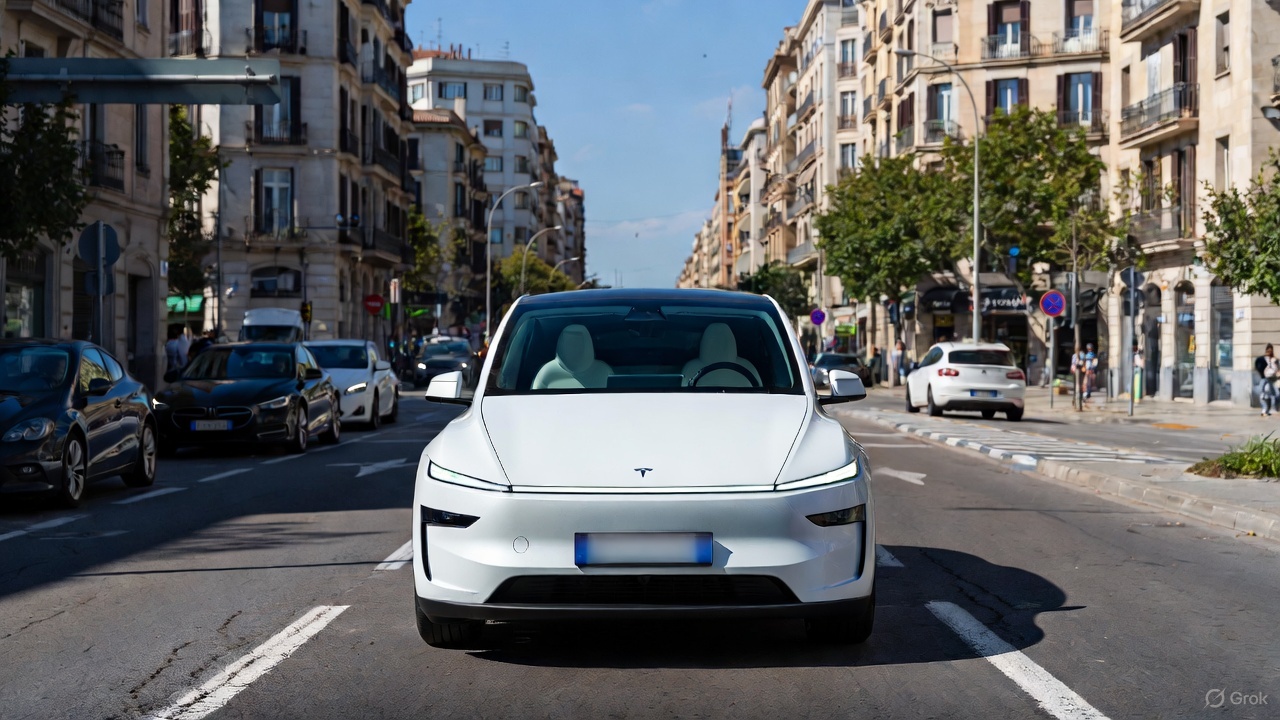
Tesla’s Full Self-Driving (Supervised) program is accelerating across Europe, with Spain emerging as a key testing hub under the country’s new ES-AV framework program.
Based on information posted by the Dirección General de Tráfico (DGT), it appears that Tesla is already busy testing FSD in the country.
Spain’s ES-AV framework
Spain’s DGT launched the ES-AV Program in July 2025 to standardize testing for automated vehicles from prototypes to pre-homologation stages. The DGT described the purpose of the program on its official website.
“The program is designed to complement and enhance oversight, regulation, research, and transparency efforts, as well as to support innovation and advancements in automotive technology and industry. This framework also aims to capitalize on the opportunity to position Spain as a pioneer and leader in automated vehicle technology, seeking to provide solutions that help overcome or alleviate certain shortcomings or negative externalities of the current transportation system,” the DGT wrote.
The program identifies three testing phases based on technological maturity and the scope of a company’s operations. Each phase has a set of minimum eligibility requirements, and applicants must indicate which phase they wish to participate in, at least based on their specific technological development.
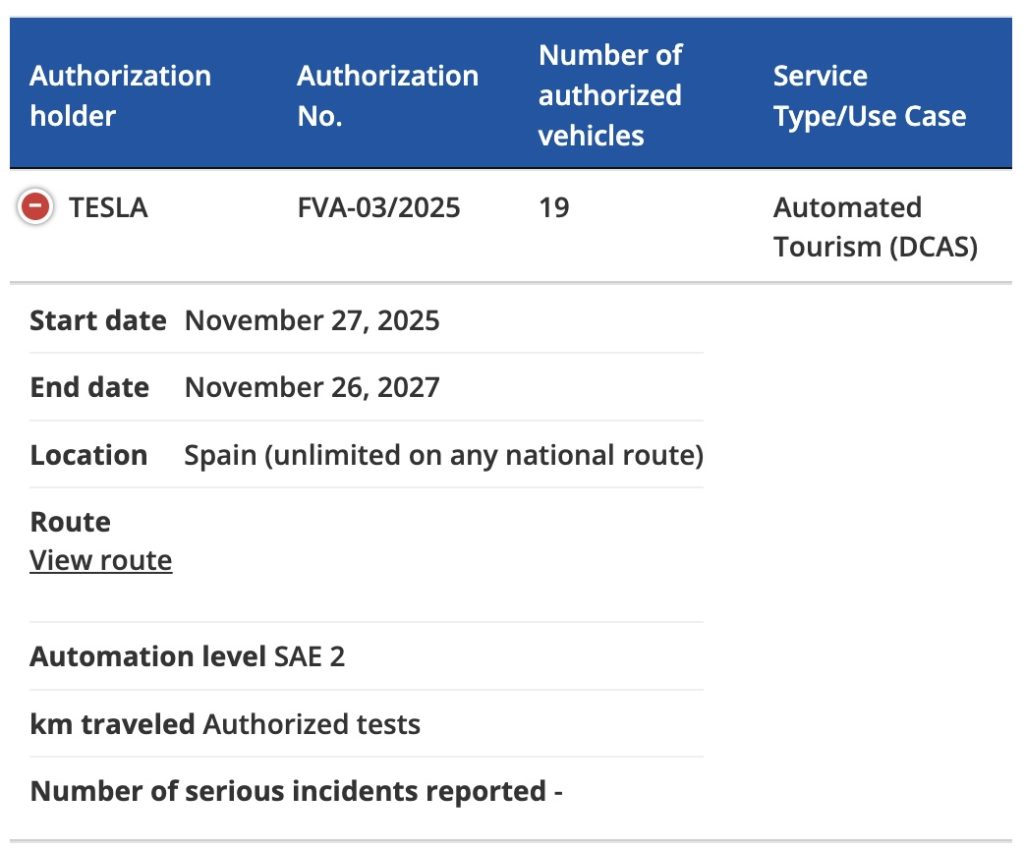
Tesla FSD tests
As noted by Tesla watcher Kees Roelandschap on X, the DGT’s new framework effectively gives the green flight for nationwide FSD testing. So far, Tesla Spain has a total of 19 vehicles authorized to test FSD on the country’s roads, though it would not be surprising if this fleet grows in the coming months.
The start date for the program is listed at November 27, 2025 to November 26, 2027. The DGT also noted that unlimited FSD tests could be done across Spain on any national route. And since Tesla is already in Phase 3 of the ES-AV Program, onboard safety operators are optional. Remote monitoring would also be allowed.
Tesla’s FSD tests in Spain could help the company gain a lot of real-world data on the country’s roads. Considering the scope of tests that are allowed for the electric vehicle maker, it seems like Spain would be one of the European countries that would be friendly to FSD’s operations. So far, Tesla’s FSD push in Europe is notable, with the company holding FSD demonstrations in Germany, France, and Italy. Tesla is also pushing for national approval in the Netherlands in early 2026.
News
Tesla FSD V14.2.1 is earning rave reviews from users in diverse conditions
Tesla’s Full Self-Driving (Supervised) software continues its rapid evolution, with the latest V14.2.1 update drawing widespread praise.

Tesla’s Full Self-Driving (Supervised) software continues its rapid evolution, with the latest V14.2.1 update drawing widespread praise for its smoother performance and smarter decision-making.
Videos and firsthand accounts from Tesla owners highlight V14.2.1 as an update that improves navigation responsiveness, sign recognition, and overall fluidity, among other things. Some drivers have even described it as “more alive than ever,” hinting at the system eventually feeling “sentient,” as Elon Musk has predicted.
FSD V14.2.1 first impressions
Early adopters are buzzing about how V14.2.1 feels less intrusive while staying vigilant. In a post shared on X, Tesla owner @LactoseLunatic described the update as a “huge leap forward,” adding that the system remains “incredibly assertive but still safe.”
Another Tesla driver, Devin Olsenn, who logged ~600 km on V14.2.1, reported no safety disengagements, with the car feeling “more alive than ever.” The Tesla owner noted that his wife now defaults to using FSD V14, as the system is already very smooth and refined.
Adverse weather and regulatory zones are testing grounds where V14.2.1 shines, at least according to testers in snow areas. Tesla watcher Sawyer Merritt shared a video of his first snowy drive on unplowed rural roads in New Hampshire, where FSD did great and erred on the side of caution. As per Merritt, FSD V14.2.1 was “extra cautious” but it performed well overall.
Sign recognition and freeway prowess
Sign recognition also seemed to show improvements with FSD V14.2.1. Longtime FSD tester Chuck Cook highlighted a clip from his upcoming first-impressions video, showcasing improved school zone behavior. “I think it read the signs better,” he observed, though in standard mode, it didn’t fully drop to 15 mph within the short timeframe. This nuance points to V14.2.1’s growing awareness of temporal rules, a step toward fewer false positives in dynamic environments.
FSD V14.2.1 also seems to excel in high-stress highway scenarios. Fellow FSD tester @BLKMDL3 posted a video of FSD V14.2.1 managing a multi-lane freeway closure due to a police chase-related accident. “Perfectly handles all lanes of the freeway merging into one,” the Tesla owner noted in his post on X.
FSD V14.2.1 was released on Thanksgiving, much to the pleasant surprise of Tesla owners. The update’s release notes are almost identical to the system’s previous iteration, save for one line item read, “Camera visibility can lead to increased attention monitoring sensitivity.”
News
Tesla FSD Supervised ride-alongs in Europe begin in Italy, France, and Germany
The program allows the public to hop in as a non-driving observer to witness FSD navigate urban streets firsthand.

Tesla has kicked off passenger ride-alongs for Full Self-Driving (Supervised) in Italy, France and Germany. The program allows the public to hop in as a non-driving observer to witness FSD navigate urban streets firsthand.
The program, detailed on Tesla’s event pages, arrives ahead of a potential early 2026 Dutch regulatory approval that could unlock a potential EU-wide rollout for FSD.
Hands-Off Demos
Tesla’s ride-along invites participants to “ride along in the passenger seat to experience how it handles real-world traffic & the most stressful parts of daily driving, making the roads safer for all,” as per the company’s announcement on X through its official Tesla Europe & Middle East account.
Sign-ups via localized pages offer free slots through December, with Tesla teams piloting vehicles through city streets, roundabouts and highways.
“Be one of the first to experience Full Self-Driving (Supervised) from the passenger seat. Our team will take you along as a passenger and show you how Full Self-Driving (Supervised) works under real-world road conditions,” Tesla wrote. “Discover how it reacts to live traffic and masters the most stressful parts of driving to make the roads safer for you and others. Come join us to learn how we are moving closer to a fully autonomous future.”
Building trust towards an FSD Unsupervised rollout
Tesla’s FSD (Supervised) ride-alongs could be an effective tool to build trust and get regular car buyers and commuters used to the idea of vehicles driving themselves. By seating riders shotgun, Tesla could provide participants with a front row seat to the bleeding edge of consumer-grade driverless systems.
FSD (Supervised) has already been rolled out to several countries, such as the United States, Canada, Australia, New Zealand, and partially in China. So far, FSD (Supervised) has been received positively by drivers, as it really makes driving tasks and long trips significantly easier and more pleasant.
FSD is a key safety feature as well, which became all too evident when a Tesla driving on FSD was hit by what seemed to be a meteorite in Australia. The vehicle moved safely despite the impact, though the same would likely not be true had the car been driven manually.


